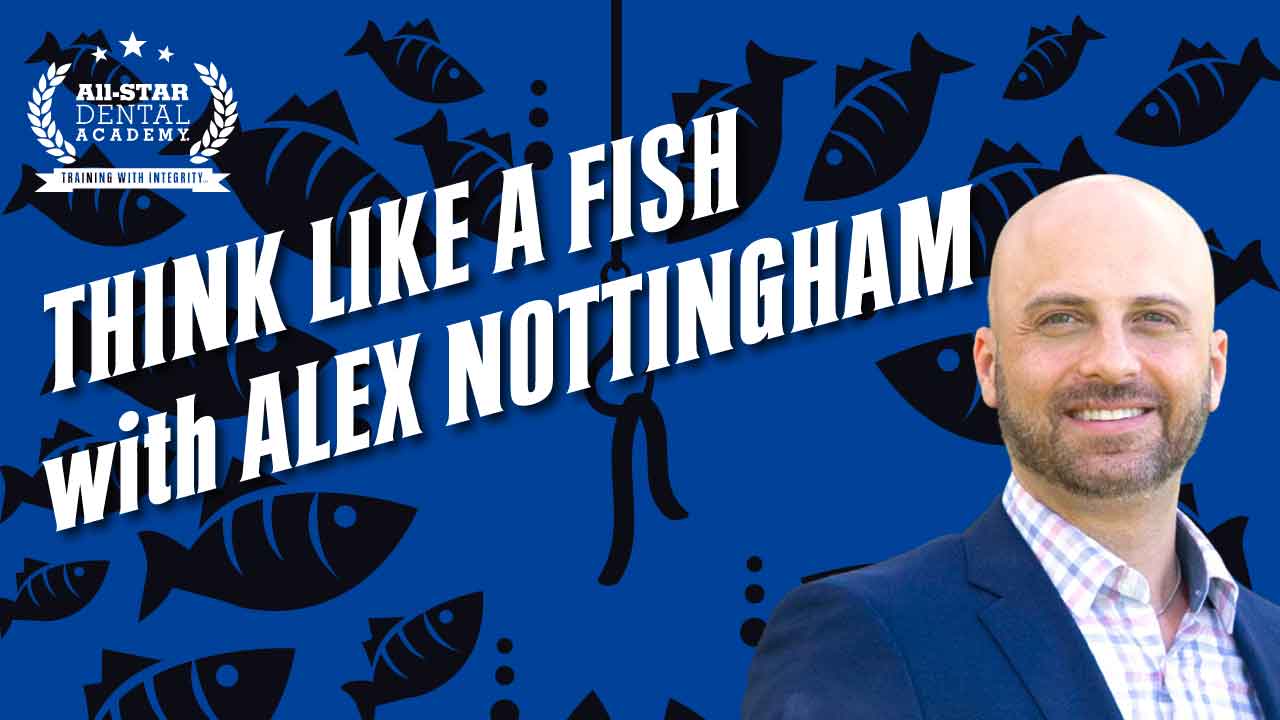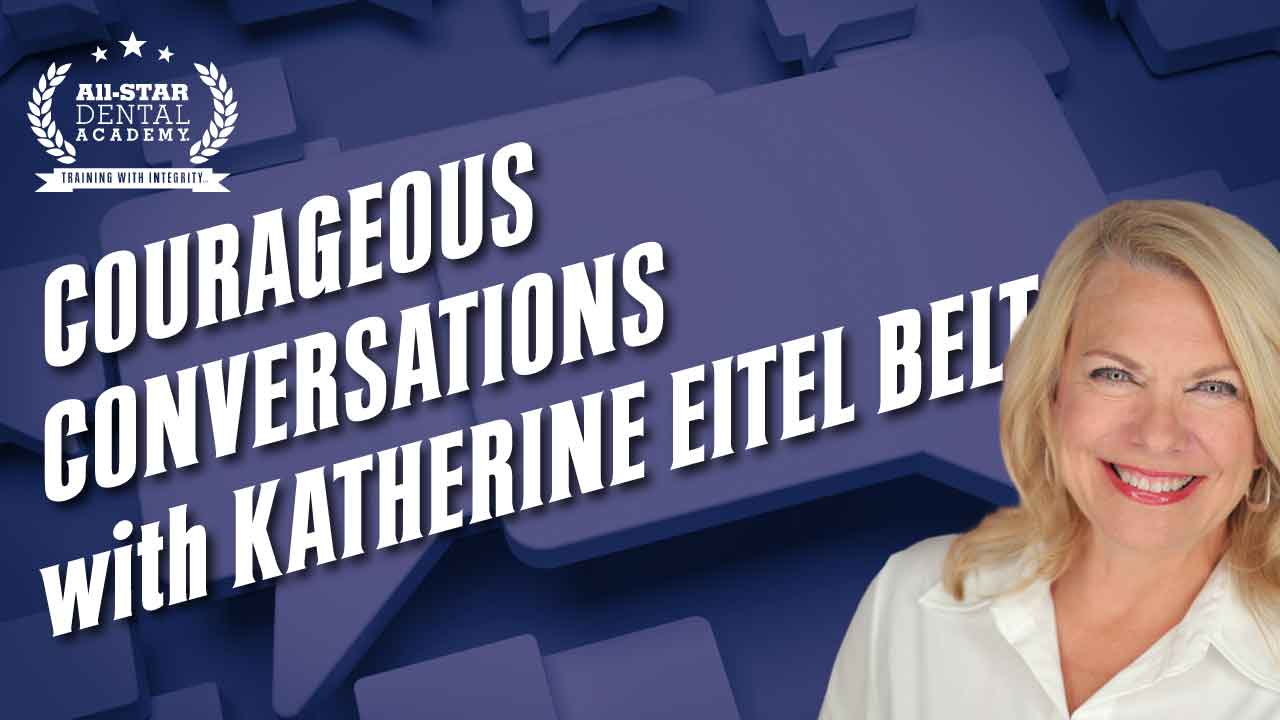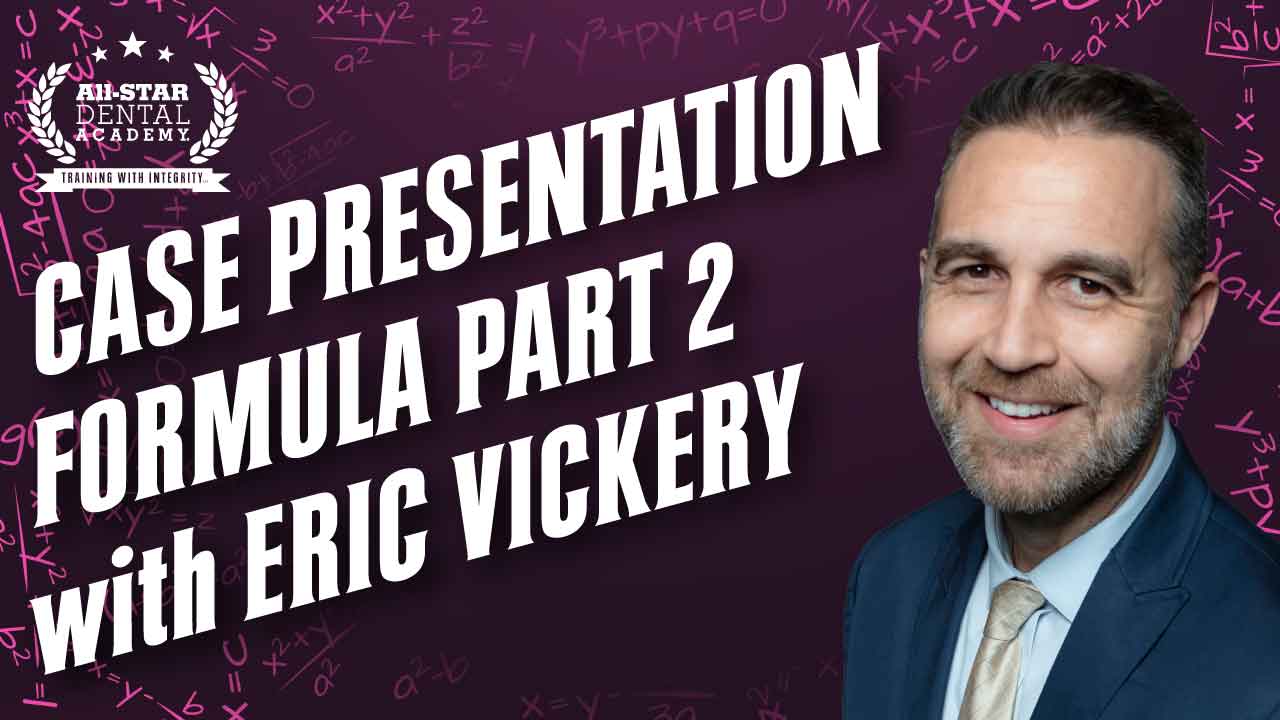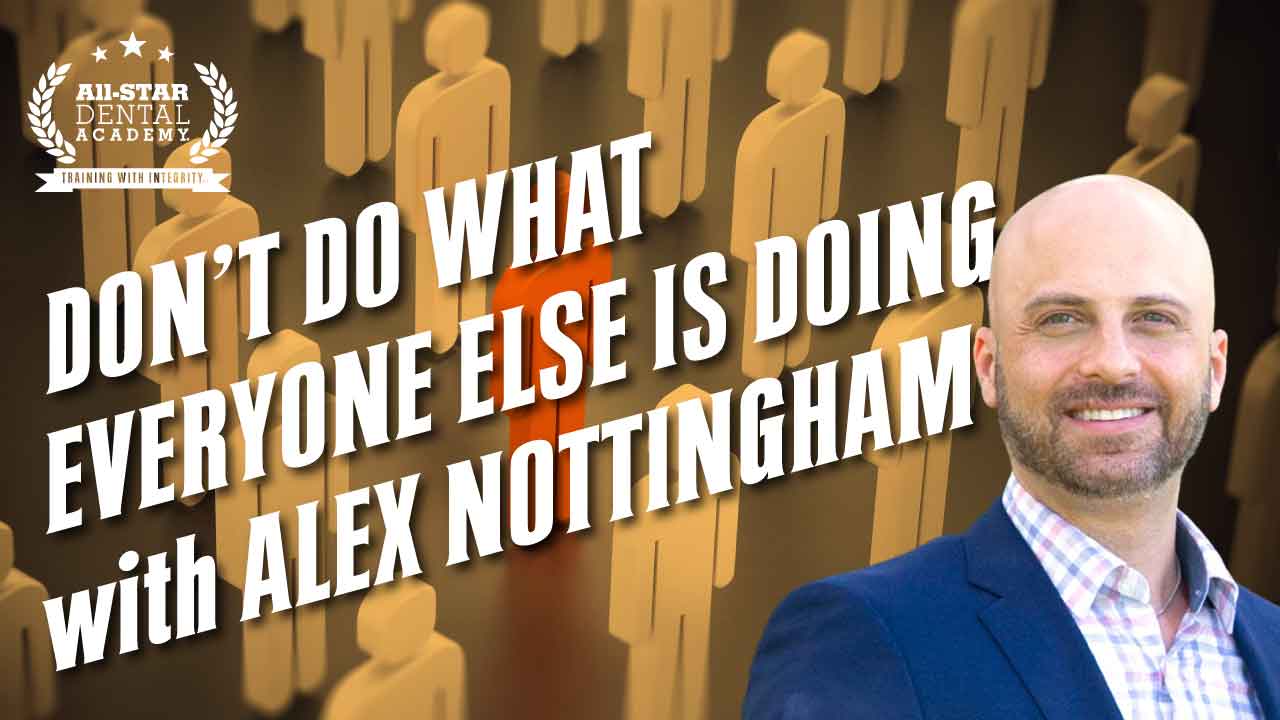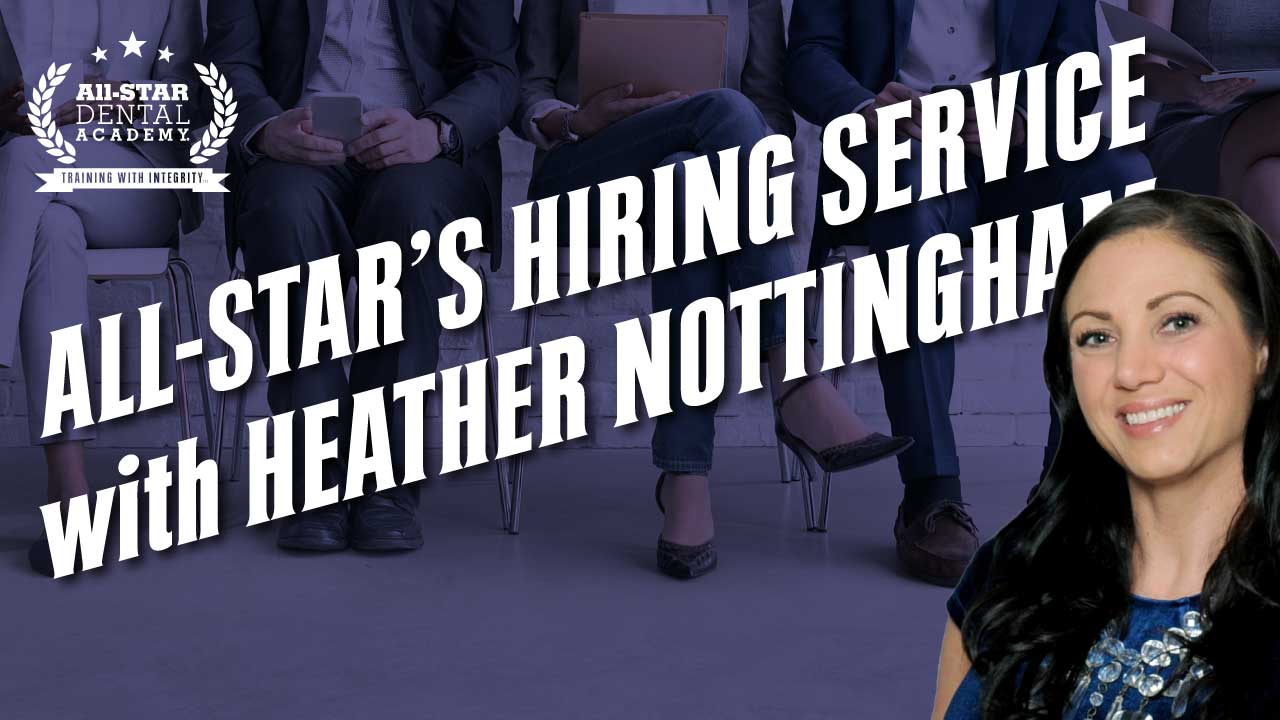Larry Guzzardo discusses how understanding DISC personality styles improves communication, leadership, and teamwork for enhanced relationships and productivity.
Resources:
About Larry Guzzardo
All-Star’s Head Instructor, Consultant. Larry is a highly sought after dental practice consultant and international speaker. His skill and talent is offering practical, common sense solutions to improve dental practice productivity. He is also a faculty member at the Dawson Academy. Larry has delivered countless presentations including, “Winning Patient Acceptance of Fine Dentistry,” “Working with You is Tearing Us Apart,” and “The Leadership Challenge.”
About Alex Nottingham JD MBA
Alex is the CEO and Founder of All-Star Dental Academy®. He is a former Tony Robbins top coach and consultant, having worked with companies upwards of $100 million. His passion is to help others create personal wealth and make a positive impact on the people around them. Alex received his Juris Doctor (JD) and Master of Business Administration (MBA) from Florida International University.
Episode Transcript
Transcript performed by A.I. Please excuse the typos.
00:01
This is Dental All-Stars, where we bring you the best in dentistry on marketing, management, and training. Here’s your host, Alex Nottingham. Hey, everybody, and welcome to Dental All-Stars. I have Larry Gazzardo, our head instructor, who needs no introduction. He is the best. We’re so happy to have him. Thanks for being here, Larry. Great to be here, as always. We had our big summit a few months ago.
00:29
And you and Eric were talking about DISC. And so I did a podcast about this kind of explaining what DISC means, and we’re kind of building on DISC. So it wouldn’t be bad to do a review to what DISC is, what it stands for. And we’re gonna look at how we can utilize DISC to learn the personality styles of ourself as well as being better leaders. So tell me a little bit about DISC and what it stands for.
00:59
your perspective on its helpful or usefulness, and then we’ll get into some of the questions. Yeah. Well, you know, DISC is a personality profile. It’s not a test, you know, so it’s not a psychological or a psychiatric type of test that says this is some kind of disease that you have or something that you suffer from. It’s a profile, and it tells us what you’re likely to act like in a certain situation.
01:29
It tells us about your tendencies. And so it helps us to know how to communicate and how to direct people when we understand the different personality styles. And review for me, DISC. What do they stand for? So DISC, there’s four basic personality styles. D is what we call the dominant style. I is what we call the influencing style.
01:57
S is what we call the steady style, and C is what we call the cautious or conscientious style. So it’s four different personality, or basic personality types that we’re referring to.
02:13
And in your opinion, I mean, you’ve been using this for years, decades. How have you found this to be useful or helpful in a dental office? Well, it’s, it’s, it’s useful. It’s helpful in, in all of our communication, but it certainly helps when we’re leading others, um, because our, our, our goal should be to make other people feel comfortable with us. Like my goal in communicating today should be to have you feel comfortable with me.
02:42
When you feel comfortable with me, my comfort level goes up. And when I feel comfortable, you can act more natural because neither one of us will act natural when our comfort level is low or our stress is high. And so if I wanna be able to influence you, if I want you to listen to my ideas, if I want you to consider what I’m thinking, you’re
03:10
only going to do that from a place of comfort, if I’m making any sense. And so it does. And by me understanding your personality style and knowing mine, then I can kind of adapt as to, okay, this is a, so I tend to be more DI and you’re more SI, correct? I’m more SI, yes. And so I have to, I can’t come in barreling through. I have to be a little bit more thoughtful. Right.
03:40
that warm charismatic, that’s not going to work. Right. Yeah. And so, and so what helps us is because we recognize I’m going to respond better. If you could recognize what I need to be able to communicate with you. Uh, the obstacle that we all run into is that we always have this one size fits all. And so we just say, well, I’m a D and so I’m going to be a D when I go to this meeting.
04:07
But what the D forgets is that probably turns off three quarters of the room. And so they don’t engage and they stop listening and there’s no interaction. And so you’ve defeated your whole purpose of getting together and having the meeting. Gotcha. Yeah. And what would you say? So we’re talking about like being a good leader and you can become a good leader and communicator by understanding this in yourself, in your team.
04:36
What are some obstacles that you see happen for leaders with respect to communicating with their team or maybe they’re not utilizing this properly? Tell me a little bit about that. Well, it goes back to that one size fits all, particularly if we walk into a situation where we don’t feel comfortable or our stress level is a little bit higher than usual. It’s very natural for us to seek comfort. And so what makes me feel more comfortable is if I act more like myself.
05:06
But let’s say for instance, I have a slower approach. Mine’s a little bit more methodical. Um, I want more camaraderie and all of that. But if I’m talking to somebody who goes, Hey, I just want to get this done. You know what I mean? And I need you to hurry it up. You see how my stress level is now going to go up. But the only way I can seek comfort as a human being in that situation is actually by acting more like myself. But as I become more methodical.
05:34
As I become more slower in my approach, you know what I mean? As I’m looking to get along better with everybody else, what’s that doing to the driver that I’m talking to? It’s raising their stress level. And so they become more like a driver. Hey, hurry it up. Can’t you get to the point? Is there a point to this story? Can’t you just tell me what you want? Lalalalalala. Now I don’t know what to do anymore.
06:02
And so that’s where we start to bump heads and then we just separate from each other. And so the problem there is both parties lead that situation thinking the other one’s an idiot. I can’t work with this person. When in reality, if both of us would have taken the time to realize, you know what? I see that you communicate differently than I do. And if I can learn to communicate a little bit more the way that you do,
06:29
your comfort level is going to go up, meaning your stress is going to come down. It will help me relax and we can get right to the point, which is what you wanted. And now I have the ability to give that to you. And so what we forget is that we all want to be comfortable and we do that by making the other person feel more comfortable with us when we’re communicating with them. That’s our biggest right there.
06:56
And I find that often we, and with respect to disc, we go back to what we’re comfortable when we’re stressed or become more of that framework when we’re stressed and that, like, so you see when somebody’s not communicating well, they get more combative, the D will get more combative, right? The S or C will slow things down. Yep. I will try, right. The, I will try to make friends with the situation.
07:23
So it’s having that self-awareness of, A, in general, how am I normally? And then stressed, how am I? And I think when we’re trying to persuade or influence or communicate, it’s very, what was this? Stephen Covey, famous, and this is actually, this is Dale Carnegie, is being more interested than interesting. And so it’s more about where are…
07:51
they coming from, how can I get to know them? Oh, oh, they’re a C or they’re an S. And then I can act appropriately to that. How do we identify ourselves, we don’t know our disk, and how do we analyze others? How do we know what they are? You can take a profile, you know, they are available on the internet. You can take a profile to pinpoint you in the right direction, but you can also look at how you do things yourself.
08:20
You know, if I’m more into results and maybe less into details and people and things like that, I’m probably more of a D or a C. But if I’m more into people and the process of doing things, then I’m probably more like an I or an S. So you can start to pair things down that way to figure it out. But the best way to do it is to go online. Look up.
08:50
look up the disc profile and take one of them. So know thyself first, figure out what you are. And then once you study the disc, because we all have aspects of each part of these frameworks, and disc is a very basic personality profile, it’s very quick and dirty. And what’s nice is you can go, oh, I see what this person is immediately. And if you studied what, because I know you’ve given some trainings and some handouts where not only understanding what they are, but
09:19
How do they handle stress? How do they handle certain situations? And then you know what to do. And this is what we talk a lot about in our programs is being prepared. And you have to be prepared with the right verbiage. And now we’re taking this to make this more advanced. And we talk about this at our summit as well as our mastery series events. And I’ll put a link in the show notes to our events page where you can learn more. We do seminars every year on disc because it’s so important. And I hate the burst.
09:48
y’all, you’re a bubble, but not only do you have to be great at phone skills and broken appointment verbiage, but you have to be able to communicate that to people and the right way. So if you don’t know who you are and you don’t know who they are, you’re not going to, it’s like a different language. Does that make sense? Correct. Well, you’re not going to recognize how your style is different than the person that you’re talking to. And that’s where you get into trouble.
10:17
because it’s not what I know, it’s what you get. You know, it’s what you receive from me that matters. And so- It’s more advanced because you know how we talk about tone tonality? Yes. Not only is, so you have to watch your tone and tonality with respect to who you’re talking to. Correct, because it counts for everybody. But there’s also pace of speech and there’s how quickly you get to the matter at hand. Some styles want you to take your time.
10:46
You know what I mean? Others want you to do it very, very quickly. And so you’ve got to respect those differences because when we don’t, that’s where my comfort level either goes up or goes down. And so we don’t communicate with anybody we don’t feel comfortable with. Well, you mentioned differences. So how can we utilize differences to our advantage at work? Well, you can use them to an advantage. Let’s just say something simple, like how people make decisions.
11:16
You know, these tend to make decisions very decisively, very quickly. Once they have enough information, they don’t need all the information. They just need enough of it. But once they get it, they’re going to decide. And it’s usually pretty much like a steel trap. And people like that about them. It’s like they have made up their mind. It’s done. Good. We don’t have to worry about it. But when we look at some of the other personality styles, we see some stark differences, like the eyes, they’re very spontaneous in the way that they make decisions, meaning they’re very.
11:45
easily influenced by what other people say or other things that they see. So as quickly as they make a decision, they could change their mind. And so it’s important to know that how this person is different than say, the dominant style. If, if we look at the S personality style, they can only make decisions by talking to other people. If you’re going to sit there, if you’re a driver and you’re going to talk to an S and you say, I need you to decide right now,
12:13
I can guarantee you they will not. And if they do, it won’t be their real decision. They will either cancel that appointment later or they just won’t show up because they don’t do well under social pressure. And so they’ll just give you an answer because you’re forcing them. It’s smarter for us to recognize, hey, you need some time. So it’s the same thing with the cautious or the conscientious type. They need lots of data and they need to study it.
12:42
and they need to look it over. They can make up their own mind. They don’t have to talk to other people. And they’re not influenced by other people when they make a decision, but they never make a snap judgment because they do it with the facts. They say to themselves, I have studied everything. I see this as a good decision. So my point here is if I’m a high D, if I’m a dominant style, and I’m talking to any one of these other styles, and I’m asking them to hurry up and make a decision.
13:09
what I’m going to get is a bad decision from them. One that they probably won’t honor or they won’t keep. On the flip side, let’s say if I look at how people utilize time, that’s a big thing and when you’re coaching somebody, the dominant style doesn’t want their time wasted. Hurry it up, let’s get this done. You know what I mean? The eyes on the other hand think they have more time than what is actually available.
13:38
And so what it teaches us is that if you gave them a list of things to do in the morning, they think, well, I got all day to get this done. But their eyes, they love being with people. So they accept interruptions. They accept it when people want to stop and talk with them because they think they have all day. You know, it’s the eye who goes, oh my gosh, it’s 430. I haven’t done any of my confirmation calls. You know what I mean? So what it teaches us, what it teaches us…
14:07
is that if I’m that high D and I’m talking to an I, I’ve got to give them a list. Hey, these are the things that I want you to do. These two things better be done first thing in the morning by 10 a.m. These other two things need to be done before lunch. These other three things have to be done in the afternoon before you go home. But if you don’t prioritize it for them, they’re at that quarter to five. And now they’re just returning phone calls, you know what I mean? Or doing something that you expected.
14:36
to have done in the morning. And they think it’s perfectly fine. Eyes are the kind of people that you tend to get an email from them, date stamped or time stamped, at 2.15 in the morning. Cause they feel like, oh, the kids finally went to bed. My spouse went to bed. I finally got some quiet time and I could do some work. Now, you finally could do some work now. That’s how they are about time. Ess’s, Alex, they’re different about time. They’re different in that they never think there’s enough time.
15:04
See, I think there’s way more time available than there actually is. Essays don’t think that there’s enough time. And so the problem with them is they don’t see 10 minutes as something where I could probably make three phone calls, like somebody else would. They feel like, oh, I don’t have enough time to make any phone calls, or I don’t have enough time to make all of these phone calls. So, well, I won’t make any. And so they never get started on a project. And so they need your help to guide them to say, okay, you’ve got…
15:34
20 reactivation calls that need to be made today. Let’s take a look at your day. They need some help. It’s not a waste of time. Ds get very impatient with this. They’re like, oh my God, have I got to sit there and babysit these people? Like, no, you’re teaching them how to utilize their time the same way that you do. Cause you don’t let time be wasted. But they don’t see it as a waste of time. They see it as, I didn’t have enough time to do it, so I didn’t start on it. I’ll do it tomorrow. And now they’re actually behind.
16:04
Caesar, again, even more different about how they utilize time. And so again, this is important when you’re coaching them in a business setting, because they have to have enough time. And so normally with the conscientious or the cautious type, you’ve got to negotiate with them. Okay, we’ve got this project. They want 90 days to do it. You want two weeks. And so you can’t say to them, okay, you’ve got two weeks to get this done.
16:34
Because all they’ll say is, you didn’t give me enough time and I couldn’t do it. And you’re forcing me to make mistakes or skip steps. I’m not going to have it. And so again, you’re going to have to negotiate with them. So I’m just using that as a simple example. But time comes up in every issue in every office. Because we’re not like retailers that are open 16 and 18 hours a day. And if we want to do more, we just open up on weekends and holidays and stuff like that.
17:04
It, it, we’ve got to look at each style individually when, when we’re working with them, because they make decisions differently, they utilize their time differently, um, you know what I mean? And so when you understand them, it becomes easier to coach them and you like working with them better. If you’re, again, if you’re that high D style, instead of going, Oh, it’s Larry. Again, they all stick on the mud, you know, it takes them forever to get started on something, you know what I mean? You realize, Oh no, I can get Larry.
17:33
to get a lot done. You know what I mean? Cause when it looks at results and things like that, you know what I mean? That high D just wants to get it done. And so when they’re finished and they have an extra part, that strong ego style of them, they have that extra part and they say to themselves, well, that’s an extra part. I guess they packaged it wrong. You know, they don’t think that they did anything wrong. Eyes, they enjoy the process so much, they forget they were supposed to get something done.
18:01
Like when the high D doctor is going to a CE course and says, well, if you guys are coming in tomorrow, I’d like you to make some reactivation calls. You know what I mean? Remember, they enjoy doing it more than they enjoy getting it done. And so you’ve got to look at them and say, if I’m going to give you all day to do this, how many calls do you think you’re going to be able to make? You got to hear this from them. You know, how many calls you’ve got to negotiate it? How many appointments do you think we should get out of this?
18:31
Because S’s are a little bit the same way too. You say, I’m gonna be gone all day, but you guys can still come to work because we need to get reactivation done. They’re like, great, let’s bring bagels. Let’s have some fresh coffee. Everybody’s gonna run to the coffee shop and get their favorite and all that. And they’ll make calls all day long. And never realizing, you know what? I didn’t even get ahold of anybody and I didn’t even make any appointments. But when that happens and the high D guy comes back, the dentist comes back from the
19:00
uh, from the course and says, well, how’d it go yesterday? And they go, it was great. We worked all day yesterday. It goes, my, oh my gosh, you must’ve made a lot of appointments. Well, yeah, we made three and the D is like three. That’s all you made. That wasn’t even worth turning on the lights for. But now how does the S and the I feel you in great, you don’t appreciate anything. You know what I’m saying? I can never please you. And what the D needed to understand is no.
19:29
they just enjoyed the process of making the calls. They weren’t considering I needed to get something done. It doesn’t enter into their mind like it does for the D. See, it’s almost like there’s like, there’s four realities that are really happening at once. Right? And like what is, and it’s interesting because we used to think like there was one reality. Like for me being a DI, it’s D. There’s only this reality, but that’s not true.
19:58
because I could do everything right and get every, every result possible, but everybody is upset. Yes. And they’re not enjoying themselves, but I got the result. The ends justify the means not necessarily. Yes. And that’s what happens to like the S’s and I’s and the C’s. They’re like, yeah, you got it done. But my stress level was through the roof to do this. Whereas the D has to learn, Hey, let’s negotiate. Let’s talk about.
20:26
how this is going to work. If I look at a C, a C is very analytical, okay? Very analytical, they can hear an idea and they can think through it very, very quickly and go, that won’t work. Well, sometimes we feel like, you’re the most negative person I’ve ever met. It’s like, no, it’s just that they can work through things better than we can. You know, eyes are like, that’s a great idea, let’s do it. But it never dawns on them, it won’t work either. You know? Everything’s a good idea for an eye.
20:54
Yeah, exactly. And assets are like, that’ll never work, that’ll never work, because they don’t want to get started on it, you know, because it means they’ve got to learn something new. But my point is, what what you have to do with these individuals is that we have to learn how to I don’t know what happened to my computer here.
21:15
When we’re dealing with these different styles, what we have to learn, I’m sorry, Alex, something just happened to my computer. Timed out or something like that. They’ll fix that. You and technology. Technology is a whole nother situation. I wonder what your computer is, Disc. What’s your computer’s personality? Because Larry, your time was up. Oh, it’s a D. No, but what I was, that’s a D. What I was talking about was that,
21:42
When you’re working with people, where were we? We were talking about, oh, getting results and all that. Right, right, we were talking about getting results and all that, is that you have to negotiate with them. Oh, I’m sorry, no, what we were talking about is Cs can think through things very, very quickly. And because of it, they can analyze that result. And so sometimes we think that they’re very negative when they’re not. I’s and S’s aren’t very analytical. It’s not their fault, it’s just the way that they are.
22:12
And so I always want to go along with an idea, but S is not so much. But what you have to help them with is say, but if they had ideas and you didn’t accept them, they would say, you never want my ideas. I’m just not going to do this again. It’s just no fun. I don’t enjoy this. And so what you have to help them with is when they have an idea and say, you know what, I’m really glad you brought that up. They need that reinforcement. Walk me through these steps.
22:42
Help me understand how this is gonna work and then help me know what result we’re going to get. And then force them, in a way, to kind of go through it themselves. Now, they’ll probably come to their own conclusion, oh, that’s not what we were looking for, was it, that’s not gonna work. You know what I mean? Like you wanna do something and they’ll say, let’s have a bake sale. And you already know that bake sale is not gonna bring new patients into the process. You know?
23:10
But my point is, is if you poo-pooed that idea, because Ds can do that very quickly, Cs can do that as well. That’s a dumb idea, it’s not gonna attract any new patients, I already know it. It doesn’t help the I’s and the S’s think through it in their own mind. So my sense is, is you could be a more influential leader. It could be very helpful in your coaching with employees if you recognize how they’re different and what their needs are.
23:38
You know, how they look at things, how they look at getting results, how they make decisions, how they utilize their time. When you can understand that you can help them get through that. If you’re going to be here all day, what can I expect that you should be able to accomplish? And then there may be a little bit of a negotiation that goes on. What would you say, give me some action steps. I’m listening. I’m a doctor or team member. Well, how can I get better at all of this?
24:08
understanding DISC, applying DISC, understanding myself and others, working with patients. I mean, I’ll let those jump in and say, of course, because that’s my day. Hey, go check out allstrandentalacademy.com slash events. You can learn about our events where we talk about DISC at many of our events. What else would you give the listeners to do? Well, what I would tell them is, pay attention to the person that you’re talking to.
24:37
You know, if anything, if you can start to mirror their tone, you know, if you can start to mirror their pace, if they’re a fast talker, you could speed up your, the pace of your speech, you know what I mean? If they’re a loud talker and you’re a quiet talker, you know what I mean? If you talk a little bit louder, maybe they’ll come down a little bit. You know what I’m saying? So you can pay attention to those kinds of things. You can also pay attention to the kinds of questions that they ask.
25:06
because it gives you some insight to what kind of personality they have. Again, those high dominant styles, they just want to know, what do you want me to do? What are we here for? What’s going on? What’s going to happen here? Whereas the eyes just want to know, when do you want me to do it? They’re always kind of like ready to go. But the problem with that is they may go off too soon without really thinking through things. And so that’s a real important issue for them. If I’m answering your question, even for the steady style.
25:36
You know, they have to understand why things are being done. If they don’t understand why you’re going to do it, they will probably skip the step. Like for instance, if they’re reading a recipe, you know what I mean? And it doesn’t explain like, why did you say fold it in instead of stirring it in or whip it as opposed to mix it? Whatever. If they didn’t understand why, they might do one or the other, not realizing, well, one introduces air into the recipe and blah, blah, blah. And they’re like, oh.
26:05
That’s why they didn’t come out crunchy, you know, or chewy or whatever it is that you were looking for. Whereas the conscientious style, you know, they’ve got to know how things are done. They have to know, you can’t just tell them, go do it. You know what I mean? Like you, you’ve got to let them ask those questions. I’m thinking of a Heather’s phone program and I got to get her, I’m going to make a note to remind her to do a segment on the personality types.
26:32
So in her program, she has her own personality types that she adapted, not even really being as aware with this, but I guess these, these are archetypes that come like you have, uh, what is it? The, you have multiple personality profiles out there that are being used and are, and are very good ways of analyzing Drake, uh, and so on. And disk is, is, is, is pretty simple.
26:58
And I just remind me in the phone program is a whole module on like the nervous Nellie, the talker, the different types that you can put. And so just it’s, there’s many ways, I know you would say to skin a cat, there’s a nicer way of saying it, but there’s many ways to be able to just being aware. And we teach this about mirroring and matching, understanding where they’re coming from. And this is another layer of understanding yourself and others. Let me stop it there.
27:25
Blair Gazzardo, our head instructor. I really appreciate you being here. We have more to do, more podcasts to pump out here. Remember to follow us on Apple Podcasts, Spotify, and YouTube, get episodes as they are released. Share with your friends. And until next time, go out there and be an All-Star. We hope you enjoyed this episode of Dental All-Stars. Visit us online at allstardentalacademy.com.




